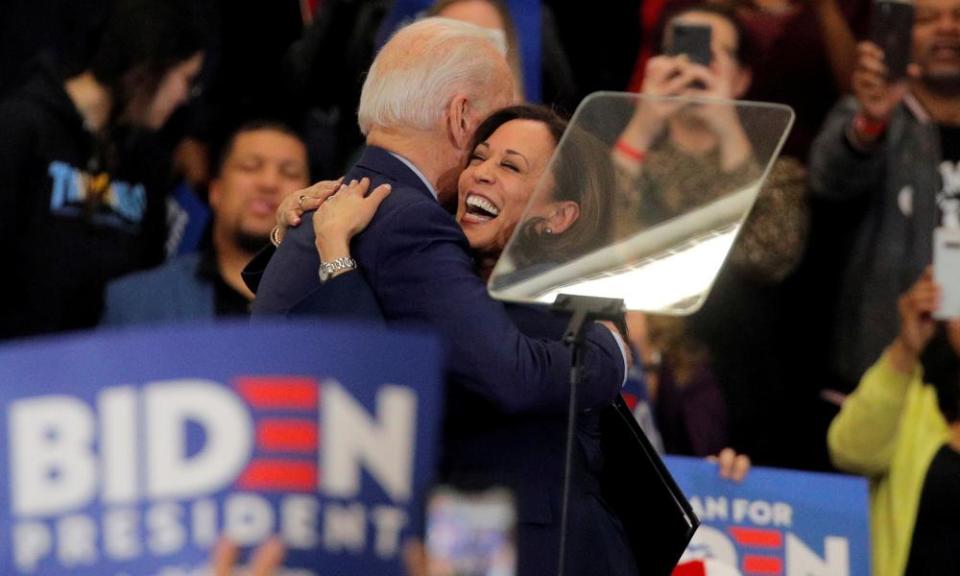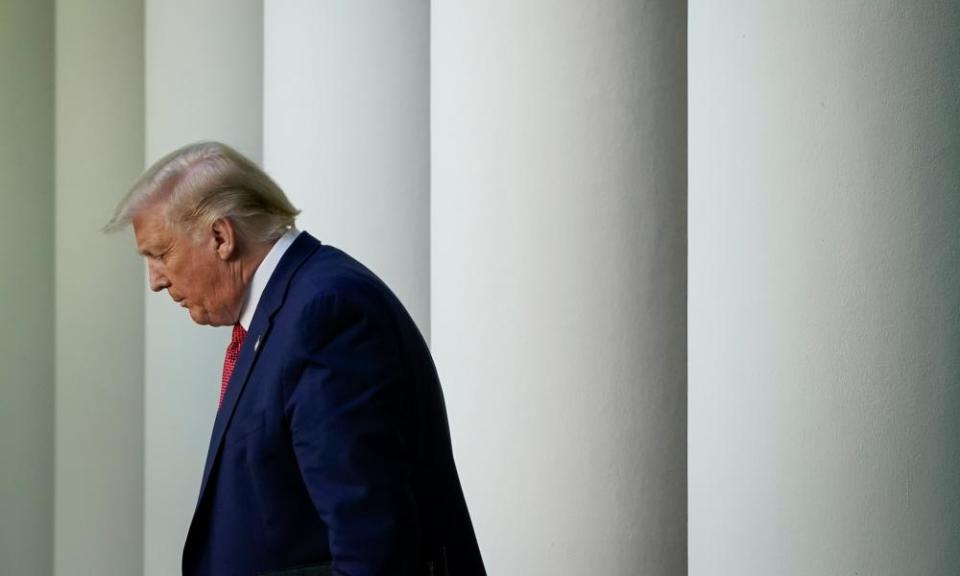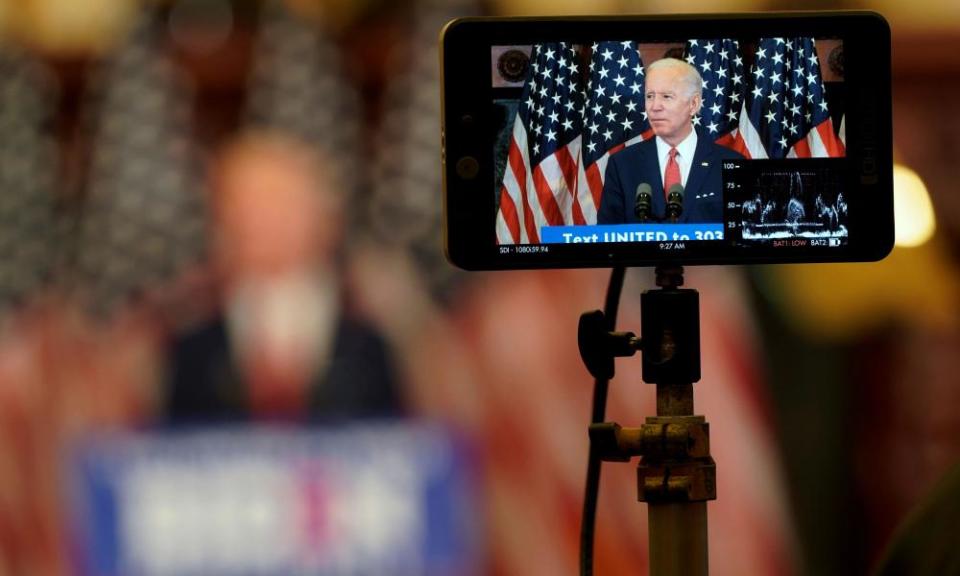The US election is entering its final stretch – here are the key areas to watch

Election day in the US is officially 3 November, but amid the coronavirus pandemic, Americans are being encouraged to take advantage of early voting initiatives that open as soon as September to decrease the risks to themselves and others.
From voter suppression to polling and debates, here are some of the key areas and figures the Guardian’s politics team will be watching as the race enters its final stretch.
Donald Trump
The Trump campaign has less than 100 days to change the dominant narratives of the year: that the president failed the leadership test during the coronavirus pandemic and missed the profound shift in public mood following the police killing of George Floyd in Minneapolis in May.
With his attempts to distract having largely failed, Trump has finally worn a face mask and promised a coronavirus “strategy” but provided few details so far. He may be pinning his hopes on an “October surprise”, such as the discovery of a vaccine, and a better than expected economic recovery, which has experienced the sharpest contraction since the second world war according to data released this week.
He has shown even less willingness to engage with the cause of Black Lives Matter, inverting it to a racist campaign theme, stoking fear of violence in cities and portraying it as an existential threat to suburbs. “Law and order” may resonate with parts of his base but, polls suggest, it may be too little too late to rescue Trump from a one-term presidency. David Smith
Joe Biden
Less than 100 days out, the Biden campaign is currently well positioned to defeat Trump in November. The former vice-president leads Trump by double digits in a slate of new national polls, as the president’s handling of the coronavirus pandemic weighs on his approval rating.
Biden has narrower but consistent margins in several battleground states as his campaign eyes an expansion in traditionally Republican states such as Arizona and Georgia, which could pave the way for Democrats to take back the Senate. And with the party largely united behind him, Biden has started to lay out an ambitious recovery plan as Trump’s edge on the economy slips.
Related: Once a Republican bastion, Arizona is now a key state that could decide the election
But there are risks, too. Though Biden is less unpopular than Hillary Clinton was in 2016, Democrats worry about his favorability ratings, which have slipped amid an advertising assault by the Trump campaign.
Biden’s supporters are far less enthusiastic about his candidacy than Trump’s supporters are about his re-election. And polling suggests Biden has more work to do to mobilize young and minority voters, who were a key part of the coalition that twice elected Barack Obama. Lauren Gambino
Biden’s pick for vice-president
A presidential candidate’s running mate is usually one of the bigger lodestars in any campaign cycle. But Biden’s pick is particularly momentous, and he has said it will be announced in the first week of August. He has vowed to choose a woman, and if he wins, would usher into the White House the first female vice-president in American history.
He has also said four of the candidate he is considering are African American. There has never been an African American female nominee on either the Republican or Democratic presidential tickets.

The selection is also important because Biden, 77, has indicated he may not run for a second term, immediately elevating his running mate into contention as his presidential heir.
Running mates rarely tip an election dramatically in one direction but it’s possible that Biden’s vice-presidential pick could help energize key voting blocks such as women or African Americans. Daniel Strauss
Swing states
The 2020 presidential election will really be fought in just a handful of states scattered across the country, which will determine the winner of the electoral college, and therefore determine who takes the White House.
In 2016, Trump pulled off a shocking victory by becoming the first Republican presidential candidate in 28 years to win Michigan, Pennsylvania or Wisconsin. Trump swept all three midwestern states, and he can only afford to lose two of them in November and still secure a second term.
But the president is also struggling to maintain control of states he won a bit more easily in 2016 – namely Florida, Arizona and North Carolina. Polls indicate Biden is pulling ahead in those battleground states, as well as in the midwest.
With only 100 days to go until the election, Trump’s campaign resources are expected to be stretched thin, and the president’s path to re-election is narrowing. Joan E Greve
Polling
Polling might be the one thing that a lot of people are decidedly not watching out for in the 100 days until the election. The failure of polls to detect Trump’s momentum in the upper midwest, Pennsylvania and Florida in the 2016 election lured many people who feared a Trump victory into a false sense of security and teed up a painful reckoning.
So why watch polls in 2020? For one thing, there’s reason to believe that state-level polling has improved since 2016. The polls then had a particular blind spot to voters without a college degree, a group that ended up voting overwhelmingly for Trump. This time around most pollsters are weighting for education. Other factors working in pollsters’ favor: there are fewer undecided voters this time, and there has been more polling in places such as Michigan and Wisconsin.

But there are good reasons, apart from 2016, to take the polls with a big grain of salt. In order to accurately interpret their data, pollsters must make predictions about voter turnout – and this year, with the pandemic, mail-in voting and aggressive Republican efforts to suppress the vote, predicting voter turnout could pose a unique challenge.
No matter how any one polling snapshot might be right or wrong, the polls are worth glancing at to see how they’re changing. A noticeable shift across the polls could indicate a narrowing or widening race. One hundred days isn’t long, but it’s enough time for twists that could decide the election. Tom McCarthy
The Senate
Trump’s falling poll numbers have rendered the Republican party into a state somewhere between anxiety and panic not only about what November’s elections will mean for the White House, but what it will mean for congressional candidates too.
“The mood is like probably what it felt like when you were on the Titanic,” Joe Walsh, a former congressman from Illinois, recently told the Guardian.
Republicans realise they could lose everything, with the presidency and Senate following the House of Representatives, which they surrendered to the “blue wave” in the 2018 midterm election.
The Senate is critical, and Democrats need a net gain of three seats to flip it. If Republicans can retain their majority, they will be able to obstruct significant parts of the Democratic agenda, just as they did for much of Obama’s presidency.
The Republican senators Susan Collins of Maine, Joni Ernst of Iowa, Cory Gardner of Colorado, Martha McSally of Arizona and Thom Tillis of North Carolina are all trailing in polls. Even leading Trump loyalists Mitch McConnell and Lindsey Graham face stiff challenges from Democratic opponents raising huge funds in Kentucky and South Carolina, respectively. David Smith
Voter suppression
There is deep concern about America’s ability to run a free and fair election this year. Trump is already laying the groundwork to contest the results of the election, falsely saying that increased mail-in balloting will lead to widespread “fraud” and that the election will be rigged.
There is no evidence to support the president’s claims, but his rhetoric offers another threat to America’s election infrastructure, which is already straining under the pandemic. Trump’s rhetoric is particularly concerning this year, when experts expect there to be delays in reporting official election results. Trump, they say, could use the uncertainty in the days after the election to claim victory as ballots are still being counted.
Related: The US election is in 100 days: what are the biggest threats to it?
Election officials across the country also face the unprecedented challenge of having to accommodate expected high turnout both in mail-in and in-person voting. Many states that do not typically see widespread mail-in voting have seen an unprecedented surge of requests for ballots and have struggled to keep up with them, while some states, such as Texas, have refused to ease restrictions around mail-in voting, even amid Covid-19. Thousands of mail-in ballots have been rejected during the primaries, and even more could be blocked this fall, for technical reasons.
Election officials are also scrambling to figure out how they can staff the polls and find places for polling sites as the people and locations that would typically serve drop out because of concern over the virus. Republicans in Congress have also refused to allocate much money to states to help them run elections; one estimate says states need about $4bn to upgrade their election systems, Congress has allocated just $400m so far. Sam Levine
Foreign interference
US intelligence agencies found that the Russian government, under the direction of Vladimir Putin, conducted a coordinated campaign to influence the 2016 election, which aimed to damage Hillary Clinton’s presidential bid and undermine the US democratic process.
In a statement to Congress this month, William Evanina, the director of the National Counterintelligence and Security Center, said Russia was again using a range of methods to weaken the US ahead of the 2020 election, including online disinformation “designed to undermine confidence in our democratic process and denigrate what it sees as an anti-Russia ‘establishment’ in America”.
Intelligence experts have warned that the US this year will be most vulnerable to a foreign disinformation campaign in the immediate aftermath of the vote, if the outcome is close and there are disputes over the legitimacy of the vote count.
Evanina also issued a warning about Chinese and Iranian interference, saying the three campaigns represented “a direct threat to the fabric of our democracy”.
Democrats, however, complained that the warning was far too vague, and created a false equivalence between the activities and intent of the three countries. They see Russia as by far the most urgent threat in terms of seeking to undermine confidence in democratic institutions, for example by amplifying Donald Trump’s unsubstantiated claims that postal ballots are subject to rigging. Julian Borger
Conventions
The coronavirus pandemic has dampened both parties plans to stage conventions in late August, where presidential nominations are traditionally conferred in front of massive, cheering crowds.
Trump recently canceled the Republican national convention events in Jacksonville, Florida, amid record numbers of coronavirus cases and deaths in that state. The change-up came after the president’s insistence on packed crowds compelled the party to move the event to Florida from North Carolina, where the governor had balked at hosting a full-scale event.
Democrats still plan on having Biden accept his nomination in Milwaukee, Wisconsin, though the party officials have urged most attendees to stay home. All the official business – setting rules, adopting a policy platform and formally nominating Biden, will be conducted remotely.

This will be the first time in modern US history that the major parties have abandoned crowded conventions, a tradition they upheld during the civil war and second world war.
By giving the event a miss, Democrats and Republicans are also losing a chance to galvanize supporters in crucial swing states. Despite the restrictions this year, both parties have promised a spectacle, with “exciting” TV programming and virtual celebrations. Maanvi Singh
Debates
The two septuagenarian presidential nominees are set to go head-to-head in three televised presidential debates between 29 September and 22 October, with one vice-presidential debate.
After initially threatening not to take part, the Trump campaign has recently pushed for an additional debate in September, arguing that the coronavirus crisis could prompt much earlier voting. But the debate format also suited Trump in 2016, when the then candidate loomed behind the Democratic contender Hillary Clinton, mocked her and threatened to jail her, and his campaign will be hoping to dominate the stage again.
But Biden’s campaign has said it will not “ride the rollercoaster of the ever-changing Trump campaign position on debates, nor are we going to be distracted by his demands”. Enjoli Liston

